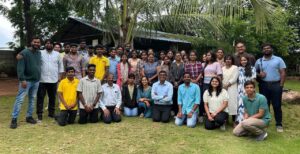Agrifoodtech investment grew sharply in India, Mexico, Vietnam and some other developing markets in 2024 against a 4% decline in global funding. However, the picture in 2025 is a looking a little more uncertain, in no small part due to “Trump, tariffs, and trade” as Mark Kahn at agrifoodtech investor Omnivore puts it.
“Geopolitical risks, such as the growing US-China tensions, could disrupt global commodity trade and lead to protectionist policies. Furthermore, food inflation and supply chain instabilities may push governments toward interventionist policies, affecting startups in food processing, logistics, and farm-to-fork models,” predicts Kahn, one of several agrifoodtech investors surveyed by AgFunderNews for its new agrifoodtech investment report into developing markets, launching tomorrow.
Moreover, “further weakening of the global macroeconomy and tightening liquidity could adversely impact investor sentiment and capital availability for agrifoodtech startups, especially in longer gestation spaces such as novel food systems, agribio and synthetic biology,” warns Shruti Srivastava at Avaana Capital.
Indeed, increased geopolitical tensions and trade restrictions “will inevitably adversely affect businesses in developing markets,” predicts Maurice Scheepens at Dutch entrepreneurial development bank FMO, while currency movements and protectionism in developed markets could lead to “increased reluctance to invest overseas,” says AgFunder’s Asia director John Friedman. [Disclosure: AgFunder is AgFunderNews’ parent company.]
That said, there are solid grounds for optimism, says Friedman, who predicts that the “strong exit pipeline in more mature markets like India will boost confidence and put a positive spin on recent negative news flow.” Similarly, he says, “Southeast Asian startups are going back to basics, proving the fundamentals, and attracting fresh capital to validate the investment opportunity.”
“Increasing urgency for climate-adaptation solutions on the back of climate volatility could also increase agrifoodtech activity in developing markets where climate challenges threaten agricultural supply chains and farm incomes,” says Kahn at Omnivore.
With more “climate disasters” likely, meanwhile, “I would hope and expect to see alignment between capital, innovators, enterprises and policy on building, supporting, deploying and scaling climate-smart solutions for food and nutrition security globally,” adds Srivastava at Avaana Capital.
Where is the smart money going?
Looking ahead, Friedman at AgFunder expects “to see China re-emerging as a technology leader with a big announcement either in capability or policy breakthrough, if not necessarily headline funding amounts,” while Bernardo Milesy at GLOCAL expects to see “integration platforms, consolidation in the precision ag space, new data management tools for farming and the supply chain, and new ag insurance solutions.”
Juan Martin Ninfea at Pampa Start Venture Capital expects to see more activity in AI and biologics in developing markets, meanwhile. “The trend is clearly AI. In addition to biologics, which is seeking to consolidate itself in a more sustainable stage, we see some [investment] cases with hardware or machinery usually discarded by VCs.”
He also expects to see continued interest in marketplaces and supply chain innovations dues to the nascency of the ecosystem.
“AI-driven agtech should attract the most capital in 2025, particularly platforms that combine predictive analytics, interoperability, and embedded finance,” said Ariadne Caballero at Latin American VC SP Ventures. “New chemistry and biologicals should also draw serious funding but with a stronger focus on regulatory-ready, scalable products that prove ROI under tough field conditions.”
On a regional basis, 2025 “will be the best vintage ever for agrifoodtech in Latam,” predicts Francisco Jardim at SP Ventures. “Capital scarcity, high quality entrepreneurs and strong maturity of multiple technology trends create the most fertile environment of our generation.”
A shift from the Silicon Valley VC model?
At the Climate Resilient Africa Fund, Sherief Kesseba expects to see a “shift towards an SME fund structure rather than the Silicon Valley VC model. Agrifintech solutions will continue to evolve and will act as gateways to expand reach and impact within the African food system.
“Supply chain innovations will grow and address inefficiencies in the value chain. Biotechnology will play an increasingly important role in the continent with both home-grown innovations and global innovations that previously did not have a route to market into Africa and can now benefit from the thriving startup ecosystem that has created formal, structured and digitized consumer mega clusters.”
Meanwhile, Kahn notes “India’s transformation into a hardware innovation hub [in 2025]” as a “significant development. The convergence of climate-adaptive agricultural technologies, advanced manufacturing capabilities, and circular economy solutions presents a powerful model for sustainable development that balances economic growth with environmental stewardship—a blueprint for global challenges ahead.”
‘Super-specialist’ startups
Megha Okhai at British International Investment, in turn expects to see more highly-specialized startups addressing very specific pain points along the value chain in developing markets. “Full-stack platforms are overrated and gradually going out of vogue even with founders,” she argues. “While startups offering an end-to-end ‘one-stop-shop’ solution make sense on paper, this business model hasn’t consistently shown success.
“Challenging and expensive execution outweighs the potential to drive stronger stickiness, brand value and capabilities do not automatically translate across to new offerings and the list goes on.”
In future, she says, we will see “super-specialist founders playing to their strengths in building deep solutions for very specific pain points along the value chain.”
As we see “growing standalone pools of value creation along the value chain,” she adds, “we expect to see an increased need for collaboration and consolidation. Founders are open to this now more than ever, and we continue to facilitate South-South collaboration across our portfolio in Africa, India and Southeast Asia. Are these the beginnings of the makings of a Global South agtech super app?”
Omnivore’s Kahn added that he thinks more startups from the EU and US will deploy their solutions in developing markets.
The biggest surprise of 2024…
And the biggest surprise of 2024?
“The speed at which biologicals moved from promise to performance in the field,” says Caballero at SP Ventures. “Especially in markets like Brazil and India, where farmers demand ROI, not theory.” She also notes that over the year founders were “sharper” with more “grounded” models and says that “capital is rewarding execution over hype. Ecosystems are maturing, and the strong are starting to prevail.”
When it comes to funding, several investors predict more capital going to agrifintech this year, while Srivastava at Avaana Capital expects to see a large number of deals in the “agriwaste-to-value/ agriwaste biorefinery segment,” along with more capital flowing into quick commerce grocery.
Indeed, the biggest surprise of 2024, she claims, was the surge of capital into quick commerce in India, “despite the model’s inherent appeal to a relatively narrow consumer base—primarily upper-middle-class and affluent urban households.
“With 10-minute grocery delivery priced at a premium, many expected limited scale potential in a price-sensitive market. Yet, investors have bet big on high-density demand pockets, private label expansion, and operational efficiencies to unlock margin viability.”
‘We need to show this space can and does make money’
As for the biggest challenges facing the agrifood industries in developing markets, the impact of foreign exchange movements, a lack of access to capital, and a “lack of sophistication across the capital stack to enable companies to scale” are top of mind for investors.
Tough times force startups to up their game, agrees Megha Okhai at British International Investment: “The ongoing market reset continues to drive founder and investor discipline with a sharpened focus on unit economics. As founders increasingly specialize and play to their strengths, we look forward to a growing wave of collaboration and consolidation.”
Others also point to the highly fragmented nature of the market across most developing nations as an opportunity to make money.
“Developing markets offer the most compelling agrifoodtech investment opportunities in 2025,” argues Cabellero. “The problems are urgent and globally relevant, founders are deeply connected to the field, and valuations remain grounded. It’s where practical solutions are being built and where global scale is most likely to emerge.”
Ultimately, says Kesseba at the Climate Resilient Africa Fund, “We need to show that this space is not just suitable for grants, donations and philanthropy but can and does make money.”
Kahn agrees. “The life and material sciences space in India is transitioning from R&D-heavy to commercialization-ready, presenting compelling entry opportunities for private investments. While technical talent density rivals global hubs, the capital intensity required for scale remains undersupplied, creating attractive valuation entry points. There is no time like the present for investors across every stage to step in and this is a trend that will pick up in the coming year.”




